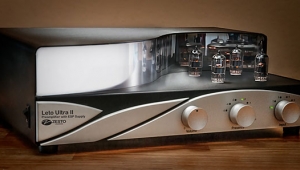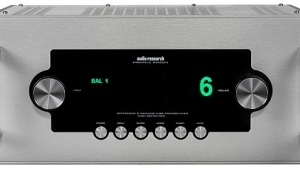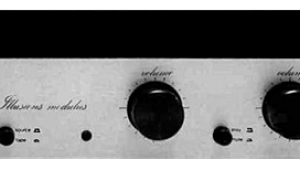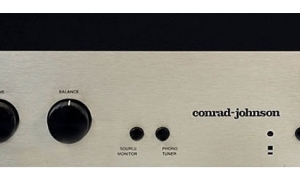| Columns Retired Columns & Blogs |
Blue Circle BC3 Galatea line-level preamplifier Mk.II, December 2004
Art Dudley wrote about the BC3 Galatea Mk.II in December 2004 (Vol.27 No.12):
In western Virginia, where towns have names like Mouth of Wilson and Fancy Gap and Meadows of Dan, there lives a rural mail carrier named Wayne Henderson who has also spent much of the last 40 years hand-building guitars and mandolins in his home. With more than 200 instruments to his credit and a waiting list measured in years, Henderson is said to be looking forward to his retirement from the Postal Service, so he can increase production and maybe catch up on his backlog of orders. Among the people he's kept waiting are Gillian Welch and Eric Clapton.
I've never met Wayne Henderson, but I know people who have, and they all describe him as sharp-minded and kindly—and a superb picker in his own right, not coincidentally. Every instrument he builds is a custom order, made to the owner's specifications. By the same token, he has his own strong ideas about how things ought to be made, and he'll politely decline any project that fails to interest him.
In other words, the person who buys a Henderson guitar buys a little bit of Mr. Henderson.
I can't help feeling our own hobby is enhanced by those few builders who do things that same way, in part because it flies in the face of the more common notion: that all consumer electronics are mass-produced, presumably someplace where life is cheap.
You can think of Blue Circle Audio as a manufacturing company, and I guess that's true: It's a business with phones to answer and parts to order and all that. But as far as designing and building home audio gear is concerned, Blue Circle is essentially one person, and that's Gilbert Yeung. If you buy one of Mr. Yeung's preamps, you're buying something that he built and then listened to, personally, before you got hold of it. And he did it in Canada, where life is anything but cheap.
There's no mistaking the Blue Circle BC3 Galatea Mk.II preamp ($4995) as anything but a handmade product. Its audio circuit is wired entirely point-to-point, and its stainless-steel casework, while not exactly roughly finished, is by no means slick. Fine with me.
The BC3 Galatea Mk.II, which displaces the BC3 Galatea (reviewed by Chip Stern in the August 2000 Stereophile), is a single-ended line-level preamplifier with five pairs of input jacks, two pairs of output jacks, and a tape loop. It uses only two tubes for audio amplification—one 6922 dual triode per channel—and its solid-state power supply is housed in a remote enclosure. Most notably, the preamp's volume controls are in fact rotary arrays of low-tolerance discrete resistors. Each individual control takes several hours to build, by—you guessed it—hand.
The BC3's physical styling is no less noteworthy: The generously sized enclosure is made from stainless steel, brushed to a nice finish, and the four very large knobs—one volume control and one source selector for each channel—are machined from a variety of solid hardwoods. (My sample had oak knobs, but I've also seen the company use a gorgeous deep red cherry that would be a great match for the Brazilian cherry floor in my listening room.) And for once, a company's logo is not so much an afterthought as a jewel in its crown: a target-shaped window of blue acrylic, lit from behind with a low-voltage bayonet bulb, the likes of which I used to buy for my old Alfa's dashboard.
The original BC3 Galatea was bumped to Mk.II status through a number of enhancements. Its outboard power supply, which was previously dual-mono only from the B+ rail forward, is now split into two channels all the way back to its toroidal transformers. Inside the preamp proper, a suspended board was replaced with a new wiring layout, with vibration isolation for the tubes now handled by silicone "bubbles." Larger coupling capacitors for the main outputs have been added, to extend bandwidth even further in the DC direction. And the tubes, which were once shared between the channels, are now separated out, to reduce capacitive coupling and its potential for crosstalk: Each side now has its own 6922, the first half of which is a class-A voltage gain stage, the second half of which is a buffer.
As you can guess from the number of gain stages, the Galatea Mk.II inverts signal polarity from input to output, and users are advised to swap their speaker cables, positive for negative and vice versa, at the amplifier—unless, of course, their amplifier also has an odd number of gain stages, in which case they're advised to do nothing. Users can also match the Galatea to their power amp of choice by adjusting the former's volume-control range to suit the latter's gain—a flick of the internal switch next to each resistor array is all it takes. Whether set for the high range or the low, the Galatea's generous 23.5dB of line-level gain should be enough for anyone. The only remaining concern is to make sure the input impedance of one's amplifier is sufficiently well matched to the Blue Circle's 180 ohm output impedance that flat frequency response can be relied on. (My 55k ohm EAR 890 amp was certainly no problem.)
My own preamplifier, a Fi, is also built around the vigorous 6922 dual triode, so I was interested to learn how the Blue Circle would compare. Unsurprisingly, the two preamps sounded remarkably similar, each delivering an unambiguously big soundfield full of realistically rich instrumental colors and textures, and both playing music in a satisfyingly tuneful, timeful way. I love the sound of the orchestra on Hilary Hahn's 1998 recording of the Beethoven Violin Concerto with David Zinman and the Baltimore Symphony (CD, Sony Classical SK 60584), and the Blue Circle played it well. The very first kettledrum taps were deep and beautifully controlled—no electronic overhang—with a halo of complex overtones and a believably human feel to the playing. The remaining measures were equally entertaining, with an even greater degree of drama than the very fine Fi: On disc after disc, I heard no compression whatsoever—only great music.
The Blue Circle was well-mannered in every regard. It had no apparent texture of its own, and spoke only when spoken through: There was no hum or other such noise that I could hear. Its top end was especially clean, with no "underlining" of note attacks or spatial cues—and none of the exaggerated tape hiss I hear, inexplicably, from certain other contemporary preamps.
And I admit preferring the dual-mono volume-control scheme over all others: The BC3 Galatea allowed me to center the soloist relative to my listening position, without an extra balance pot gumming up the works. The volume control's steps were just fine enough to suit me. My only serious complaint was the absence of a simple mute button, which is necessary if one wants to silence the system without altering the volume settings. A less serious complaint was the mildly rickety feel of the source selector knobs—but that has less to do with the quality of the rotary switches themselves, which are in fact quite decent, than with the fact that the outsized knobs exert more leverage on those switches than they're apparently designed for.
It's worth pointing out that a number of options are available for the Galatea Mk.II. As mentioned, Blue Circle allows their customers to choose control knobs made from a variety of woods—and even, for a small extra charge, stainless steel, to match the rest of the unit. Other cover colors are available (some for no extra charge), and a small premium can even buy a customized front panel. The purist BC3 Galatea Mk.II is even available with a remote control: For an additional $500, Gilbert Yeung installs an extra pair of volume controls (traditional potentiometers) and remote circuitry. The new pots can be set wide open—in which case they have no effect on the sound—or dialed in gradually to attenuate the volume.
All of which, of course, speaks to the way Blue Circle does business: Most of the pieces that leave their assembly room are unique in some way. (If you want a fly-yellow preamp with black oak knobs and an extra processor loop, you can have it.) But even if you buy their stock preamp, you're buying a little bit of Gilbert Yeung. I'm not sure I'd want, say, a handbuilt dialysis unit, but in a hobby like this, where technology is intended to serve art, such craft is a precious commodity—and Blue Circle deserves credit for carrying the torch. Enthusiastically recommended.—Art Dudley
- Log in or register to post comments




































